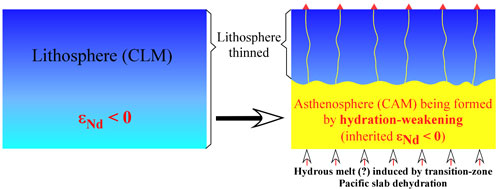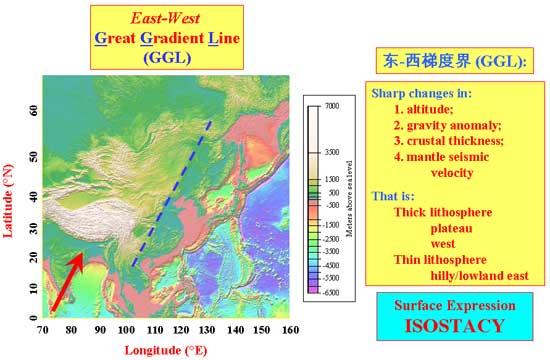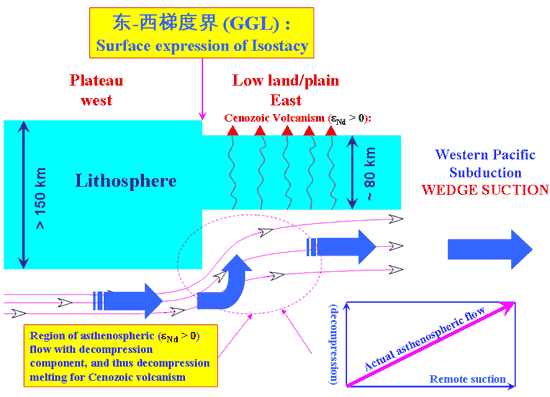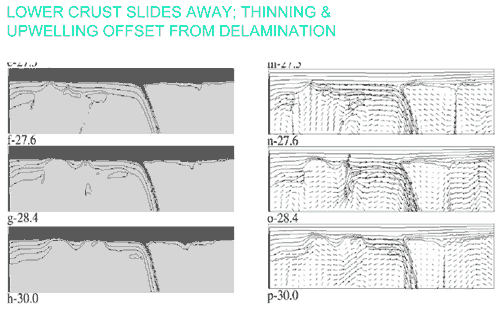 |
Continental
lithospheric thinning results from hydration weakening,
not “delamination”, and is a special
consequence of plate tectonics |
Yaoling
Niu
Durham University,
Durham DH1 3LE, UK, yaoling.niu@durham.ac.uk
1. Terminology
and concepts
In recent years, the term
“delamination” [Ed: see Lithosphere
thinning pages, and also Continental
delamination and the Colorado Plateau by P. Bird,
for an explanation of what delamination is and isn't]
has been developed into a model whereby the basal portions
of locally or regionally thickened continental mantle
lithosphere, and possibly also lower crust, sink into
the deeper mantle. Most recently, lithosphere delamination
has been suggested to cause continental volcanism. My
objective in this webpage is to encourage interested
readers to take away the following Q-and-A messages
and to remain skeptical of the proposed mechanism and
deduced consequences of continental lithosphere "delamination".
Q: Can subcontinental
lithosphere be thinned?
A: It is difficult, but it happens in some places.
Q: Can it happen by “delamination”?
A: It is possible, but extremely difficult and perhaps
unlikely.
Q: Why is it difficult?
A: Because the lithosphere is too buoyant to sink into
the dense asthenosphere.
Q: How then could the
lithosphere be thinned?
A: Its basal portions can be transformed into convecting
asthenosphere.
Q: How?
A: By hydration-weakening.
Q: Where does the water
come from?
A: It comes from recently subducted oceanic lithosphere.
Thus, this method of lithosphere thinning is a special
consequence of plate tectonics.
Compared with the young
(< 200 Ma) ocean crust, the continental crust is
rather old, on average > ~ 2.5 Ga. This is because
the continental crust is protected by the similarly
old continental lithospheric mantle (CLM) from the underlying
convective asthenospheric mantle (CAM). Since its inception,
much of the CLM (in contrast to oceanic lithosphere)
has been isolated from mantle convection. The protective
power of the CLM arises from its depleted composition
(high Mg/Fe and low Al2O3) and
physical buoyancy relative to the CAM. It is physically
buoyant because it comprises light minerals with high
Mg/Fe, lacking dense garnet due to low Al2O3
etc. It is true that the CAM is hot, whereas the CLM
is cold. However, because of the negligibly small thermal
expansion coefficient (~ 3 x 10-5 K-1
of mantle peridotites), the density contrast due to
the compositional differences (~1%) cannot be overcome
without heating the CLM by ~ 300 K. In other words,
in order to reduce the buoyancy contrast so that the
CLM may sink into the CAM, the CAM must be additionally > 300K
hotter. This is impossible, and therefore,
the CLM cannot delaminate and sink into the dense CAM.
Straightforward arguments of this kind must be considered
when evaluating the likelihood of physical models.
2. Hydration-weakening
and the best example
There is evidence that
the CLM has indeed been thinned in some places. One
of the best examples is eastern China in general and
the North China Craton (NCC) in particular. There is
every reason why the CLM root of ancient cratons should
be stable indefinitely, but this is not the case beneath
the NCC. The existence of Paleozoic diamondiferous kimberlites
in the NCC indicates that the eastern China lithosphere
must have been ~ 200 km thick in the Palaeozoic. However,
petrologic studies of Cenozoic volcanism and mantle
xenoliths, as well as seismic studies, show convincingly
that the present-day CLM beneath eastern China is no
more than 80 km thick. Thus, the lithosphere beneath
eastern China must have lost more than 120 km of its
original thickness, probably in the Mesozoic. “Delamination”,
“large scale extension and stretching” and
“thermal erosion by mantle plumes” have
been suggested as the cause. As explained above, however,
the “delamination” process is physically
unlikely. Evidence for extension exists, but it is inadequate
to explain the observations. As a final resort, mantle
plumes were invoked to explain the lithosphere thinning
in eastern China and the intra-plate volcanism there
in the Mesozoic and Cenozoic. However, there is no evidence
of any kind in favor of mantle plumes in the region.
Alternatives are needed. I offered an alternative interpretation
[1], where I suggest that the Mesozoic lithosphere thinning
and Mesozoic/Cenozoic basaltic volcanism in eastern
China are a special consequence of plate tectonics.
Mesozoic lithosphere thinning
in eastern China is best explained by a process that
“transformed” the basal portion of the lithosphere
into convective asthenosphere by hydration (Figure 1).
The water required may have come from dehydration of
subducted Pacific (or predecessor) oceanic lithosphere
that is presently lying horizontally in the transition
zone beneath eastern Chinese continent, where it is
detected by seismic tomography [2]. The Mesozoic volcanism
may be genetically associated with the lithospheric
thinning because the basaltic source is ancient isotopically
enriched (εNd < 0; [3]) lithosphere being converted
into asthenosphere (Figure 1).

Figure 1: Cartoon illustrating
the concept that continental lithosphere can be thinned
through “hydration-weakening” at its base
[1]. That is, the basal portion of the lithosphere can
be transformed into “asthenosphere” by water-induced
viscosity reduction. In the case of eastern China, the
water may originate from dehydration of subducted Pacific
plate that lies horizontally in the transition zone
[2]. The water probably rises in the form of hydrous
melt although the exact form is unconstrained. The associated
basaltic volcanism would probably have an isotopically
enriched signature (i.e., εNd < 0) that is inherited
from ancient metasomatized lithosphere that is being
transformed into “asthenosphere”. In this
figure, "Continental lithospheric mantle"
is considered to be "cold", rigid, strong,
highly viscous/elastic and isolated from convection.
"Asthenosphere" is considered to be
"hot", soft, weak, less viscous and part of
the convection system.
The NNE-SSW Great Gradient
Line (GGL; Figure 2) marked by sharp altitude, gravity,
crustal thickness and mantle seismic velocity changes
from the plateau in the west to the hilly plains of
eastern China reflects the variation in lithospheric
thickness from probably > 150-200 km thick beneath
the plateaus in the west to probably < 80 km thick
beneath eastern China (Figure 2). The “remote”
western Pacific subduction system “wedge suction”
[1] induces asthenospheric flow from beneath eastern
China towards the subduction zones, which in turn requires
asthenospheric material replenishment from beneath the
western plateaus to eastern China (Figure 3). As a result,
such eastward asthenospheric flow experiences upwelling
and decompression as it passes from beneath thickened
to thinned lithosphere, which causes it to partially
melt and fuel Cenozoic eastern China basaltic volcanism
(Figure 3). Such volcanism may have begun at the end
of the Mesozoic lithosphere thinning in the late Cretaceous
[4].

Figure 2: (a) Topographic
map showing a sharp altitude contrast in continental
China as indicated by the blue dashed line. This line
is called the Great Gradient Line (GGL) [1] as this
altitude contrast coincides with contrasts in mantle
seismic velocity (higher in the west than in the east)
at 100-150 km depth, (2) Bouguer gravity anomaly (lower
in the west than in the east), and crustal thickness
(higher in the west than in the east). These consistent/coincident
east-west contrasts are interpreted as the expression
of isostacy – reflecting thin lithosphere in the
east and thickened lithosphere in the west [1]. Lithosphere
thinning in eastern China is generally accepted to have
taken place in the Mesozoic (see Figure 1), but lithosphere
thickening in western China (plateaus) is interpreted
as being genetically associated with the Indian-Asian
collision since the Cenozoic [1].

Figure 3: Cartoon showing
asthenospheric flow and Cenozoic volcanism in eastern
China. The lithosphere is thick beneath high plateaus
in western China and thin beneath eastern China (see
Figure 2) across the Great Gradient Line (GGL). Western-Pacific-subduction-induced
“corner-flow” requires asthenosphere replenishment
from the west [1]. In response, the eastward flow of
asthenosphere beneath eastern China requires replenishment
from the west beneath the plateaus. The latter flow
experiences decompression of > 50 km vertically,
which will result in decompression melting and Cenozoic
volcanism in eastern China. As the source is the asthenosphere,
this model explains the isotopic depletion of Cenozoic
volcanism (i.e., εNd > 0). Note, the asthenosphere
flow is driven by a “wedge-suction”-induced
pressure gradient [1], and it is NOT the same as “edge”
convection.
This hypothesis, which
requires further testing, is consistent with available
observations and complies with straightforward physics.
The proposed mechanism of lithosphere thinning thus:
-
does not require
hot mantle plumes beneath eastern China; the horizontally
lying transition-zone slabs [2]act as a cold thermal
boundary layer that absorbs heat from above and
below, thus preventing hot mantle plumes from rising
from the lower mantle and traversing the upper mantle
[1];
-
does not require
lithospheric “delamination”, which suggests
that deep portions of the buoyant cratonic lithosphere
sink into the dense asthenosphere – a scenario
that is physically unlikely;
-
does not
require lithospheric extension/stretching the scale
of which was limited in the Mesozoic;
-
explains the
lithosphere thinning beneath all of eastern China,
not just the NCC; and thus
-
questions
the significance of South China continental subduction
as a cause of lithosphere thinning beneath the NCC.
The suggested mechanisms
for Mesozoic/Cenozoic volcanism in eastern China are
consistent with the geochemistry of the basalts [3],
physical scenarios of mantle melting [1] and geophysical
observations [1,2]. The latter principles and observations:
-
do not favor
a hot mantle plume origin for eastern China volcanism;
-
do not support
the suggestion of oceanic-ridge-like passive mantle
upwelling and decompression melting because there
is no unambiguous evidence for large-scale rifting
or lithosphere separation in eastern China since
the Mesozoic;
-
argue that
the eastern China Mesozoic/Cenozoic basins may not
comprise evidence for continental extension and
rifting. These basins may be an isostatic response
[1] to horizontally lying dense slab materials in
the transition zone.
Important points to note are:
-
the NNE-SSW
GGL (Figure 2) [1] is probably a young feature that
results from Indian-Asian collision since the early
Tertiary;
-
subduction-zone
dehydration is necessarily incomplete [1,5] because
of formation of stable hydrous phases in subducting
slabs. For example, in the subducting crust, lawsonite
forms. It can contain ~ 11 wt % H2O,
and is stable up to 11 GPa [6], much deeper than
expected subduction-zone dehydration. Importantly,
serpentines within subducting lithospheric mantle
[5] contains up to 13 wt % H2O, and is
stable up to 7 GPa [7] before being transformed
to dense hydrous magnesium silicate phases that
are stable at even greater pressures (~ 5 to 50
GPa [6,8]). This allows water transport to great
depths in the mantle [9]. All these hydrous phases
tend to decompose and form new and less hydrous
phases (e.g., Wadsleyite, < 3.0 wt% H2O;
Ringwoodite, < ~ 2.2 wt% H2O; Mg2SiO4-spinel
is essentially anhydrous) as the temperature increases
[1,6]. The horizontal slabs in the transition zone
beneath eastern China [1,5] experience isobaric
(horizontal movement) heating with time, and will
thus lose water accordingly. The water so released
would form hydrous melts that migrate upwards and
weaken the deep portions of the lithosphere (hydration-weakening)
and transform them into asthenosphere. This gives
rise to the process of lithosphere thinning [1];
-
mantle wedge
suction, while less strong than ridge suction [10],
is an important driving force for asthenospheric
flow;
-
more recent
lithosphere accretion beneath the NCC is a straightforward
consequence of conductive cooling of the asthenospheric
mantle. However, the suggestion that “new
lithosphere replaces old lithosphere” should
be avoided if it is intended to emphasize processes
or physical mechanism because it is misleading.
3. Any other
examples?
A literature search readily
reveals that wherever the concept of “lithosphere
delamination” is invoked, oceanic lithosphere
subduction was ongoing either simultaneously or shortly
beforehand. Other examples include the southern Andes,
the western USA, the western Mediterranean and Tibet.
On the other hand, mantle plumes have been proposed
to have impinged or to underlie the African lithosphere,
yet the lithosphere thinning there has only occurred
on limited scale and been associated with active rift
zones or ancient sutures. This suggests that
- thermal erosion, if thermal mantle
plumes did indeed exist beneath Africa, is ineffective
in thinning the lithosphere, and
- the role of water or hydration-weakening
is indeed the key mechanism – no oceanic lithosphere
subduction is currently ongoing or occurred in the
recent past beneath the African plate. The closest
plate boundaries to the African plate are ocean ridges,
the south Mid-Atlantic Ridge, the Southwest Indian
Ridge, the Central Indian Ridge and the Read sea spreading
centers.
A full paper describing
these ideas is presently in preparation, but the basic
concept and discussion can be found in reference [1].
4. Acknowledgement
I thank Gillian Foulger for inviting this
contribution, and Thomas Duvernay for spotting a typographic error 2nd May, 2018.
References
-
-
Kárason,
H. & R. van der Hilst, Constraints on mantle
convection from seismic tomography, Geophys.
Monogr., 121, 277-288, 2000
-
Xu, Y.-G.,
Thermo-tectonic destruction of the Archean lithospheric
keel beneath the Sino-Korean Craton in China: Evidence,
timing and mechanism, Phys. Chem. Earth (A),
26, 747-757, 2001
-
Yan, J., J.-F.
Chen, Z. Xie & T.-X. Zhou, Mantle xenoliths
in Late Cretaceous basalts in eastern Shandong:
New constraints on the timing of Eastern China lithospheric
thinning, Chinese Sci. Bull., 8,
1570-1574, 2003
-
-
Williams,
Q. & R.J. Hemley, Hydrogen in the deep earth,
Ann. Rev. Earth Planet. Sci., 29,
365-418, 2001
-
Ulmer, P.
& V. Trommsdorff, Serpentine stability to mantle
depths and subduction-related magmatism, Science,
268, 858-861, 1995
-
Frost, D.J.,
The stability of dense hydrous magnesium silicates
in earth’s transition zone and lower mantle,
Geochem. Soc. Spec. Publ., 6,
283-297, 1999
-
Kuroda, K.
& T. Irifune, Observation of phase transformations
in serpentine at high pressure and high temperature
by in situ X-ray diffraction measurements, Geophys.
Monogr., 101, 545-554, 1998
-
Discussion
28th May, 2006, Don Anderson
The term ‘delamination’ has been widely
used for the gravitational removal of the continental
lithosphere. There have been objections to this usage
of the term and it has even been questioned whether
it is possible. The term ’foundering’ has
also been used. There are other ways to remove or thin
lithosphere that involve lateral flow or detachments.
Over-thickened continental crust can also be removed
by mechanisms that do not involve a Rayleigh-Taylor
instability. The term ’delamination’ does
not imply gravitational removal, or lithosphere removal.
To avoid confusion, the term ‘crustal delamination’
should be used for the removal of lower continental
crust, by whatever mechanism. Gravitational instability
or Rayleigh-Taylor instability or foundering should
be used if a specific mechanism is being treated.
Lower crustal delamination is quite different
from continental lithosphere removal described by Yaoling
Niu in this page. It is difficult to remove buoyant
cratonic peridotite (SCLM) for the reasons described.
It is not only buoyant; it is strong and has high viscosity,
when cold and dry. Weak or wet peridotite can be removed
by lateral flow. But mafic overthickened arc and convergent
belt lower crust is a different story (Anderson,
2005). The use of the term gravitational instability
or Rayleigh-Taylor instability is misleading. The lower
crust can be removed by a variety of mechanisms and
delamination is a better and more descriptive term.
A laminated solid can be delaminated by peeling, scraping,
bending, faulting, rubbing, erosion or soaking off the
laminations. It is more likely to be a band-aide removal
or Velcro type operation than a gravitational instability
as in fluid dynamics. It is aided by water from an underlying
slab and it is most likely to occur in convergent belts
and in arcs and is therefore related to subduction,
but it is not the same as subduction.
The removal of dense lower crust should
not be confused with, or equated to, continental lithosphere
removal or a fluid dynamic Rayleigh-Taylor or density
instability. There is probably a buoyant refractory
peridotite layer in the shallow mantle (the perisphere),
of which the long-lived subcontinental cratonic root
(Archon) is part but it likely spreads laterally when
heated or fluxed, rather than delaminating or sinking.
This depleted layer or region may be the FOZO source
of high 3He/4He ratios (because
of the low U and Th content). The lower crustal (>50-km)
garnet pyroxenite, "eclogite" or piclogite
mafic root is more likely to sink, because of its intrinsically
high density.
There are two schools of thought. Many
people think in terms of Rayleigh-Taylor instabilities
and gravitational instabilities and it is fine to remove
delamination from their lexicon so it can be used more
appropriately. Much of the so-called delamination literature
also involves lithosphere rather than crust. [Ed: Click
here
to visit a webpage that clarifies terms]. Kay, R. W.,
and S. M. Kay (1993, Delamination and delamination magmatism,
Tectonophysics, 219, 177-189) first started the lower
continental crust delamination story and this is how
others think about it. It may not be a gravity or fluid
dynamic instability, as modeled by some workers.
So, there are two issues; lower crust (garnet pyroxenite)
vs ‘lithosphere’, or shallow mantle layer
(intrinsically buoyant but cold peridotite) and gravity
instability vs tectonic removal (erosion, scraping,
faulting, detaching, peeling, unzipping). Confusion
concerning these terms is widespread.
I suggest that ‘crustal delamination’
or ‘delamination’ be used in the sense of
Kay and Kay (1993) for removal, by whatever mechanism,
of the lower continental crust. Discussions of the removal
or thinning of the mantle part of the section usually
involves a specific mechanism that does not fit into
most definitions of the word ‘delamination’
(see Google and Google Images, for ‘delamination’).
I have avoided using the word ‘lithosphere’
in this paragraph until now because ‘lithosphere’
means ‘strong shell’ and has no density
or chemical connotation. The term ’perisphere’
was introduced for the refractory buoyant mantle layer;
it has no connotation of strength. ‘Archon’
is the long-lived mantle root of cratons; it probably
survives because it is cold, strong, buoyant and hav
not been exposed to high stresses.

last updated 3rd
May, 2018 |
